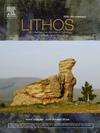Filling the gap in the UHP metamorphic record of the Liguro-Piemont Lower unit: Insights on fluid-mediated formation of atoll garnets
IF 2.9
2区 地球科学
Q2 GEOCHEMISTRY & GEOPHYSICS
引用次数: 0
Abstract
This contribution investigates the petrologic evolution of a coesite-glaucophane-bearing eclogite belonging to the Liguro-Piemont Lower unit of the Western Alps and explores the formation mechanisms of atoll garnets by integrating petrographic, mineral-chemical, and thermodynamic analyses. The studied eclogite underwent a complex metamorphic history associated with five distinct metamorphic stages: an early greenschist facies stage (<400 °C, <0.6 GPa), two prograde high-pressure stages (early pre-Dp: 450–480 °C, 1.9–2.6 GPa; late pre-Dp: 420–510 °C, 2.3–2.9 GPa), a peak-pressure stage (syn-Dp: 480–580 °C, 2.8–2.9 GPa), and an exhumation stage (post-Dp: 600–630 °C, 1.3–1.5 GPa). The coesite finding links the UHP localities already known northward (Cignana) and southward (Monviso and Val di Susa) in the Liguro-Piemont Lower unit, corroborating the coherence of metamorphic evolution across the Western Alps and filling the gap in the UHP (Ultra-High Pressure) metamorphic record of this sector of the Liguro-Piemont Lower unit. Mineral inclusion patterns and microstructural features support the involvement of aqueous fluids during atoll garnet formation. Electrolytic fluid modelling suggests a dilute aqueous fluid characterized by dissolved Si and Na, capable of selectively dissolving garnet cores and precipitating secondary garnet and omphacite. The garnet fracturing and exposure of its core is attributed to increasing fluid pressure induced by volume changes (up to 40 % increase of the inclusions' volume) related to the breakdown of the lawsonite included in the garnet mantle and to the associated dehydration reactions. These findings contribute to our understanding of fluid-mediated processes during rock exhumation and highlight the role of aqueous fluids in metamorphic reactions and mineral replacement. Also, our results call for further research to explore the link between atoll garnet formation, fluid-rock interactions, and deep paleo-seismicity.
求助全文
约1分钟内获得全文
求助全文
来源期刊

Lithos
地学-地球化学与地球物理
CiteScore
6.80
自引率
11.40%
发文量
286
审稿时长
3.5 months
期刊介绍:
Lithos publishes original research papers on the petrology, geochemistry and petrogenesis of igneous and metamorphic rocks. Papers on mineralogy/mineral physics related to petrology and petrogenetic problems are also welcomed.
 求助内容:
求助内容: 应助结果提醒方式:
应助结果提醒方式:


